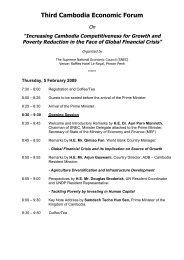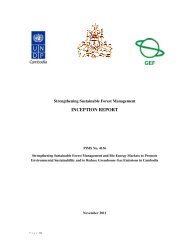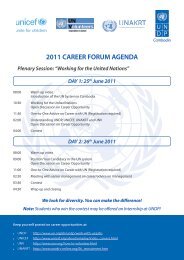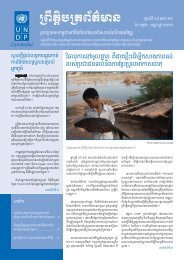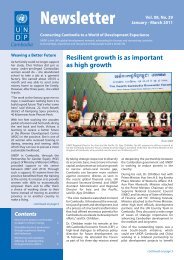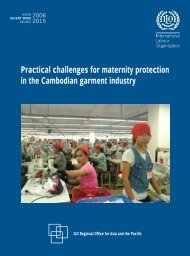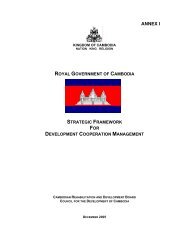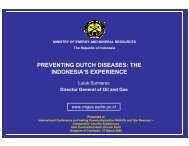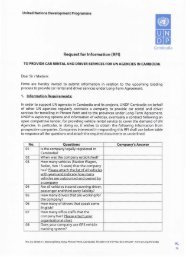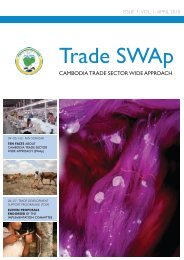UN Analysis Final.pdf - United Nations in Cambodia
UN Analysis Final.pdf - United Nations in Cambodia
UN Analysis Final.pdf - United Nations in Cambodia
Create successful ePaper yourself
Turn your PDF publications into a flip-book with our unique Google optimized e-Paper software.
The production, sale and use of drugs are becom<strong>in</strong>g <strong>in</strong>creas<strong>in</strong>gly complex and appear to be spread<strong>in</strong>g<br />
throughout the country. While data are difficult to come by, more than 80 per cent of known drug users<br />
are below 26. Most drug users are unemployed, sex workers and workers <strong>in</strong> labour-<strong>in</strong>tensive <strong>in</strong>dustries,<br />
<strong>in</strong>clud<strong>in</strong>g construction, garment manufactur<strong>in</strong>g, and truck/taxi driv<strong>in</strong>g, as well as street children.<br />
<strong>Cambodia</strong> has achieved important success <strong>in</strong> HIV prevention <strong>in</strong> recent years. Estimates <strong>in</strong> 2006 suggested<br />
that HIV prevalence among female sex workers attend<strong>in</strong>g antenatal centres was at 12.6 per cent, down from<br />
21.4 per cent <strong>in</strong> 2003. Among young pregnant women aged 15-24, the figure was 0.41 per cent <strong>in</strong> 2006. Nearly<br />
half of new <strong>in</strong>fections are now occurr<strong>in</strong>g <strong>in</strong> married women, most of whom are <strong>in</strong>fected by their husbands.<br />
Knowledge of at least one modern contraception method is almost universal; about 99 per cent of people<br />
between the ages of 15 and 49 (compared to knowledge of a traditional method which is 47.5 per cent).<br />
However, modern contraceptive method use among young females is very low (about 2.5 per cent).<br />
Attitudes about expos<strong>in</strong>g young women to discussions of sexuality are chang<strong>in</strong>g and appears to be<br />
<strong>in</strong>creas<strong>in</strong>gly accepted by parents and others <strong>in</strong> the communities.<br />
Health knowledge and key health <strong>in</strong>dicators show strong improvement. These promis<strong>in</strong>g trends, however,<br />
do not appear to apply to marg<strong>in</strong>alized groups, street youth or other disadvantaged youth. The Government<br />
and NGOs need to cont<strong>in</strong>ue to develop advocacy and awareness for health education programmes at<br />
the <strong>in</strong>dividual, household and community levels. Local authorities, Community Based Organisation (CBOs),<br />
pagodas, schools and social service providers plus medical practitioners all have important roles to play <strong>in</strong><br />
this regard. Meanwhile, knowledge and awareness of prohibited drugs is quite high.<br />
VULNERABILITY<br />
A broad def<strong>in</strong>ition of vulnerability can be derived from the Government’s policy statement on Alternative<br />
Care for Children (MoSVY 2006): Children exposed to one or more vulnerability situations have been<br />
categorised <strong>in</strong>to children <strong>in</strong> need of special protection and children at risk. Children <strong>in</strong> special need of<br />
protection and at risk <strong>in</strong>clude orphans, abandoned children, children <strong>in</strong>fected with or affected by HIV or AIDS,<br />
abused children (sexually, physically, emotionally), street children, children <strong>in</strong> conflict with the law, child<br />
victims of exploitation (whether sexual or any form of harmful labour), children with disabilities, children<br />
addicted to drugs, and children whose basic physical needs are not be<strong>in</strong>g met.<br />
Vulnerability can be a function of poverty and social exclusion, physical and mental ill health, and violence<br />
and abuse. Vulnerability can also be assessed as a function of migration, where children of poor households<br />
are <strong>in</strong>creas<strong>in</strong>gly exposed to problems associated with homelessness, violence and abuse.<br />
Vulnerability as a function of poverty and social exclusion: Young people liv<strong>in</strong>g <strong>in</strong> poor households<br />
constitute 26 per cent of the country’s population, of which about 35 per cent live below the poverty l<strong>in</strong>e.<br />
Because their livelihoods are mostly dependent on ra<strong>in</strong>-fed agriculture, these youth often experience food<br />
<strong>in</strong>security. They tend to receive less education and have little or no access to vocational tra<strong>in</strong><strong>in</strong>g. They live<br />
<strong>in</strong> households that are rout<strong>in</strong>ely <strong>in</strong> debt and have high dependency ratios. These households have dw<strong>in</strong>dl<strong>in</strong>g<br />
land resources and poor employment prospects. Issues associated with social exclusion, <strong>in</strong>clud<strong>in</strong>g disability,<br />
ethnicity, and the remoteness of communities exacerbate tendencies toward vulnerability and poverty.<br />
Situation <strong>Analysis</strong> of Youth <strong>in</strong> <strong>Cambodia</strong><br />
5




